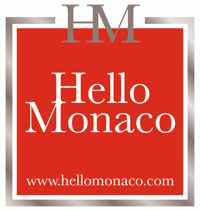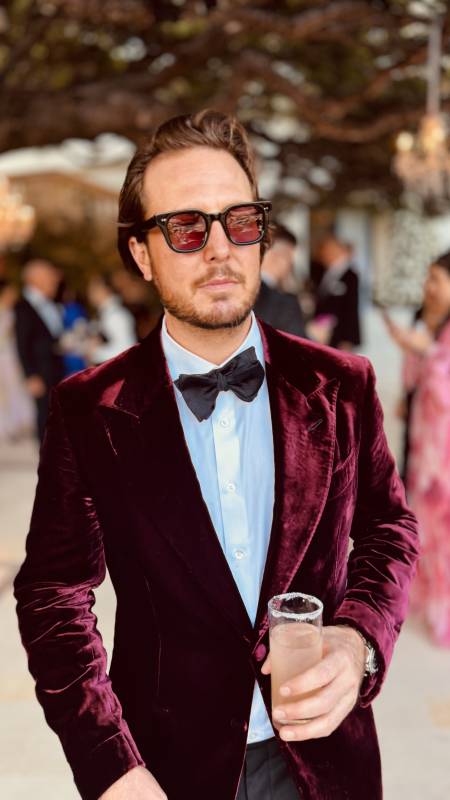Since the beginning of the ancient world, art patronage has played an important role in art and cultural life. It is documented in detail in medieval and Renaissance Europe, but is also traced in Shogun-ruled Japan, and the kingdoms of south East Asia. Artists as diverse and significant as Michelangelo, Gustave Courbet, Pablo Picasso, Cy Twombly or Keith Haring all experienced the support of patronage in its varying forms. From the Medici family, to the wealthy socialite Peggy Guggenheim, and even a teacher/obstetrician couple Mera and Donald Rubell – the business of patronage paved the way for individuals from various walks of life to become synonymous with art, its breakthroughs, and ultimately history. Evolution takes its place, and today we see the rise of digital-age patrons, who are hands-on, detail oriented, and ambitious. Meet Maria and Sassan Behnam-Bakhtiar, a Russian-Franco-Iranian art couple based between Saint-Jean-Cap-Ferrat and the Principality of Monaco.
HM: Was becoming art patrons a conscious choice for you?
Sassan Behnam-Bakhtiar: It all happened quite organically. My personal entry into the world of art was as an artist, drawing on my cultural heritage and its intricacy, while voicing a certain stance of my people in the context of the modern world and the veil of propaganda.
Maria Behnam-Bakhtiar: My husband’s outlook resonated with the Iranian and international audience gaining him global recognition and fame. It was reflected in the International media, from Britain’s Huffington Post naming Sassan «The multitalented Renaissance artist from Iran, portraying a different and necessary alternative view», to Russia’s BURO24/7, proclaiming him «The Iranian visionary who is known for his perspective on the world around him. Bringing a new Middle Eastern message to the international art world, he is perhaps one of the most sought after and must-see creatives».
SBB: We started collecting in parallel with my artistic career and deeper involvement with the contemporary art world. To get a feel of the general pulse around, we would always visit art fairs, galleries, museums and subsequently would come across works which Maria or I could not resist.

Nicky Nodjoumi
MBB: We began our collection with emerging photographers and up-and-coming artists, and as we grew in life and expanded our awareness, the acquisitions expanded to include established artists and the grand masters. Today we are proud to have one of the biggest private collections of Iranian Modern and Contemporary art in the world.
SBB: As our collection grew over the years, so did our involvement and relationship with certain artists, and the understanding of strengths and weaknesses of the system in place. Fondation Behnam Bakhtiar was born from that understanding, focusing on the universal code of art language to bring forth new inspirational sources and a forward way of thinking, while supporting selected young and established talents by providing them with necessary support in order to flourish and find their place in the contemporary art world.

HM: Talk to us about your art foundation and why its focus is primarily on Iranian Modern and contemporary art.
SBB: Fondation Behnam Bakhtiar is our outlet for social responsibility and commitment, contributing to the development of creativity for Iranian artists of all communities. Established in Saint-Jean-Cap-Ferrat, the foundation serves as a cultural headquarters providing a gateway between Iran and the world. Our unique, non-political organization constantly develops new ways of interaction, breaking barriers and crossing cultural bridges, while focusing on introduction of the necessary alternative mind-set towards Iran.
Acquisition of works for the Fondation Behnam Bakhtiar Permanent Collection, which includes works by masters of Iranian art such as Sohrab Sepehri, Parviz Tanavoli, Nicky Nodjoumi, Reza Derakhshani, Shirin Neshat and Rokni Haerizadeh, to name a few, is only a part of our core activities. The foundation also represents, supports and nurtures selected artists, such as the brilliant Farzad Kohan, as well as Sasan Nasernia, MAMI, Mostafa Choobtarash and Ghalamdar. Further activities include the biennial art prize – Behnam Bakhtiar Award, book publishing, film production and hosting of themed events.
MBB: As a Russian with Kavkaz roots on my paternal side and being brought up in the Middle East since childhood, it’s no wonder that the region’s culture is imprinted in my DNA. Naturally, I felt in love with the exquisitely rich and diverse Iranian contemporary art, which has been at the forefront of the Middle Eastern markets for over a decade. A surge of successful Middle Eastern sales by Christie’s, Sotheby’s and Bonhams, alongside online platforms such as Artnet, aided Iranian modern and contemporary artists cement a solid leading position whilst broadening their collector reach.
In fact, Bonhams first set the record in 2008 when Farhad Moshiri’s work called Eshgh (Love) sold for USD 1.45 million (highest sale for a Middle Eastern artist at that point) just to be topped up almost instantly by Parviz Tanavoli’s sculpture The Wall (Oh Persepolis) at USD 2.8 million.

artist Reza Derakshani
SBB: Iranian artists are widely represented by leading international galleries: Ali Banisadr by Blain Southern; Y.Z. Kami by Gagosian; Farhad Moshiri by Emmanuel Perrotin, the list goes on. Leading cultural institutions such as The British Museum, Tate, Centre Pompidou, the MET, Guggenheim, LACMA, and many others, all include modern and contemporary Iranian artists in their collections. This is also the case with some of the world’s leading collectors including François Pinault, Peter Marino, Frank Cohen, or, say, Tiroche Deleon Fund.
MBB: Even the world of high fashion could not resist the appeal of Iranian contemporary art. Valentino’s spring/summer 2017 Haute Couture collection was presented with the backdrop of two Shahriar Ahmadi works from his «Archaic Techniques of Chemia» series.
SBB: Our focus on Iranian modern and contemporary art, aside from my immense pride and love for my country’s culture and arts, came from the fact that Iranian contemporary artists boast excellence in their creative practices while producing truly remarkable works. The market is still in its infancy and promises a huge potential due to the talent displayed by Iranian artists and their sales records during the past decade.
MBB: I also belive that Iranian modern and contemporary art is a truly beautiful and intricate discovery for those seeking aesthetic adventure.
HM: We are very excited about the opening of your new art gallery in Monaco. Can you tell us more?

SBB: We highly anticipate the opening of our new Monte-Carlo art gallery, Galerie Behnam Bakhtiar, in winter 2017/2018. The gallery will include a roster of Iranian and international artists to better extend our efforts in the field of arts, while creating a cultural and commercial outlet.
MBB: The gallery will host four exhibitions annually, consisting of three solo exhibitions and one curated group show, alongside performances, panel discussions, art talks, and participation in international art fairs.
HM: Sassan, you are an internationally recognised artist. Tell us more about your creative journey.
SBB: My journey started in 2009 when my artwork was successfully sold by Christie’s auction house, alongside works of the Iranian masters Parviz Tanavoli, Farhad Moshiri, Reza Derakhshani, Nicky Nodjoumi, to name a few. In 2014, my work was handpicked by Sotheby’s in Los Angeles to join their showcase of prominent international contemporary artists including Glenn Ligon, Julie Mehretu, Hassan Hajjaj, Lalla Essaydi, and Rashid Johnson amongst others.
MBB: The latest of Sassan’s works to be successfully auctioned were pieces from his internationally acclaimed «The Real Me» and «Invincible» series as well as his signature portraiture works. Digital giant Artnet also sold Sassan’s works in their first and second Contemporary Middle Eastern auctions. His piece entitled «Kashan II» was the leading piece in their inaugural sale. Another pioneering digital art platform, Artsy, has also supported Sassan’s work and his mission to show the world an alternative yet necessary side of Iran, addressing the stereotypes surrounding Iran and its people. I see true appreciation amongst collectors of the fact that Sassan’s work successfully merges meaning and decorative aspects.
SBB: I see myself as a carrier of essential understanding that drives me to speak of my subjects based on their physical and mental individualism, as well as their place in history. As a citizen of the world without boundaries, I am driven by my opinion of the truth that is communicated to the outside world via my artistic forms of expression. My work originates from direct experience of the world.
HM: Why did you choose Saint-Jean-Cap-Ferrat and Monaco as your base?
MBB: I think it is impossible not to fall in love with this area. The scenery, the tranquility and nature of Saint-Jean-Cap-Ferrat pairs beautifully with buzzing Monaco and its vibrant socio-cultural scene. My husband was raised here until his teenage years, and later, as a couple, for the past 14 years, we have been spending several months a year in the region. However, we chose to permanently settle down in Saint-Jean-Cap-Ferrat when we decided to get married. Interestingly enough, certain artworks commemorate that time for us, like the Jean Cocteau mural in the Saint-Jean-Cap-Ferrat town hall where we exchanged our vows; or the artwork by Kamran Diba, the brother of Empress Farah of Iran, that he presented to us as a wedding gift. I truly appreciate how art intertwines with the Cote d’Azur «art de vivre».

SBB: As an artist, I don’t think I would want to be based anywhere else. Saint-JeanCap-Ferrat is a paradise for any artist due to its beauty and natural environment, and Monaco has always been home to me since childhood. Monaco is a very unique place which was a perfect choice as the location for our gallery due to Monaco’s solid support for arts and culture. We chose Saint-Jean-CapFerrat to host our foundation’s headquarters as this exclusive peninsula already has so much art history tied up with it, and of course we wanted it to be close to home.
Neuilly-sur-Seine born Sassan comes from a powerful and prominent family with an ancient lineage. Legend has it that the Bakhtiaris are descendants of Fereydun, a hero from Shahnameh, the Iranian national epic. They are also considered to be direct Zoroastrian descendants of Cyrus the Great. The Bakhtiaris were very influential during the revolution of the 20th century and in modern Iranian politics.
Her Imperial Highness Princess Soraya of Iran, the second wife of Shah Mohammad Reza Pahlavi and Iran’s Prime Minister Shapour Bakhtiar are members of Sassan’s family tree. His great-grandfather, Gholam-Hossein Khan Bakhtiar, was the minister of war in Iran, while Sassan’s grandfather, Hamid Khan Bakhtiar was a senator and accomplished businessman. Moreover, Sassan’s father, Behzad Behnam, was running the protocol of the Prime Minister, and was one of the founders of the Niavaran Cultural Center in Tehran.
Today, Sassan brings his own creative approach to furthering the cultural heritage of his country. His passion for Iran, support and advancement of contemporary Iranian art and culture is his contribution to the legacy of his homeland.








